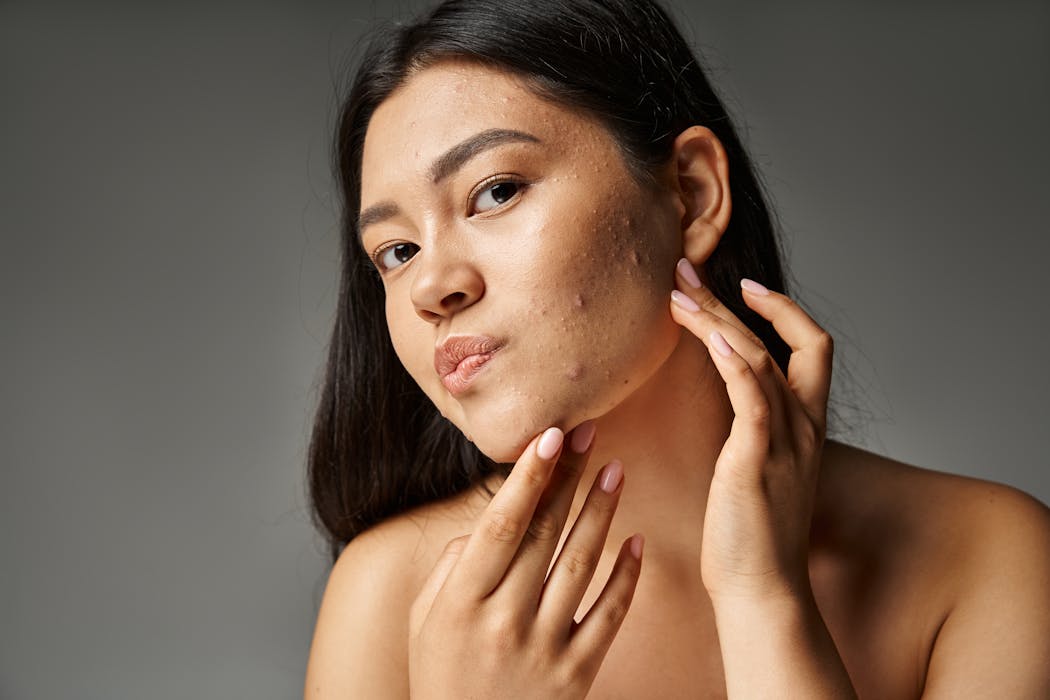
Acne is one of the most common skin conditions seen in general practice. Acne vulgaris – the most prevalent form – affects more than 80% of teenagers and young adults (in some countries, it may be as many as 95%), and tends to peak around age 18.
But acne isn’t a single condition. It appears in many forms, affects people at different ages, and can be triggered by a range of factors. Acne-like rosacea, for example, is more common in fair-skinned, middle-aged adults.
Acne may also arise from hormonal changes, exposure to certain chemicals, medications, or even from your job or hobbies. What all these types of acne share is inflammation of the skin, which produces spots and lesions of different kinds, from mild to severe.
One of the earliest and most familiar spots associated with acne vulgaris are comedones – better known as blackheads and whiteheads. Our skin is lined with tiny glands that secrete oil to keep it soft and protected. When these glands become blocked with oil and debris, they form comedones. Closed comedones appear white, while open ones darken when the clogged material reacts with air.
At this stage, acne is usually mild and non-inflammatory. Over time, however, blocked pores can become irritated and infected. When this happens, comedones can develop into papules (small, raised bumps) or pustules, which are spots filled with pus. These often become red, sore and inflamed, which helps explain why acne is so frustrating and sometimes painful.
It’s usually at this stage that the urge to squeeze the spots becomes irresistible, but squeezing rarely helps. In fact, it can make things worse, driving bacteria deeper into the skin, leading to scarring and sometimes causing large, painful cysts or abscesses. Inflammation may also trigger patchy changes in skin colour.
The underlying cause of acne in most cases is a bacterium called cutibacterium acnes, which colonises blocked oil glands. During puberty, a surge of testosterone can stimulate increased oil production, making glands more prone to clogging. Hormonal conditions such as polycystic ovary syndrome can have the same effect, as can steroid-based medications.
Read more: PCOS affects 1 in 8 women worldwide, yet it's often misunderstood. A name change might help
Other variations of acne exist. Acne excoriée is caused by repeated picking or scratching, which damages the skin and leaves scars. Acne cosmetica occurs when oil-based makeup blocks pores.
Then there’s acne mechanica, which develops when skin is irritated by friction, pressure or sweat. This type can affect athletes wearing tight sportswear, backpacks or helmet straps for long periods. Another curious example is “fiddler’s neck”, where violinists develop spots where the instrument rests recurrently on the chin.
A persistent myth is that acne results from poor hygiene. It’s an understandable assumption given that bacteria play a role, but it’s wrong. Acne doesn’t develop because the skin is dirty, and excessive washing or scrubbing can actually make it worse by irritating already sensitive areas.
Treatment
Treating acne can be challenging. There’s no single cure, but there are many ways to reduce how often it appears and how severe it becomes.
Some simple lifestyle changes can help. For instance, it’s best to avoid heavy, oil-based or fragranced products, as perfumes and strong additives can irritate sensitive skin and worsen inflammation. Products labelled “non-comedogenic” are formulated not to block pores, helping to prevent new breakouts.
Diet remains a controversial topic, but some evidence suggests that reducing sugar and processed foods while eating more fruit, vegetables and whole grains may be beneficial for reducing acne.
If these measures don’t help, topical medications are usually the next step. These include retinoids, which are derived from vitamin A and help calm inflammation, reduce oil production and prevent pores from becoming blocked.
Topical antibiotics can reduce the bacteria and inflammation that drive acne, and are often combined with benzoyl peroxide, which unclogs pores and acts as an antiseptic. However, benzoyl peroxide is also a bleaching agent, so it’s best to avoid contact with your favourite pillowcases or nightwear.
If topical treatments don’t work, oral antibiotics may be prescribed. Patience is important here: acne therapies often take six-to-eight weeks to show improvement.
For severe cases, dermatologists can prescribe oral retinoids (Roaccutane). These powerful medications can have serious side-effects and require close monitoring. As retinoids and some antibiotics are harmful to a developing baby, they are unsuitable during pregnancy.
Acne is far more than a cosmetic issue. It can cause lasting physical marks and have a profound psychological impact. Many people with acne experience low confidence, anxiety or depression. For some, mental health support is just as important as medication.
If your acne is getting worse or affecting your wellbeing, it’s important to see a doctor. Acne is common, but that doesn’t make it trivial. With the right treatment plan, and a little persistence, it can usually be brought under control.
This article is republished from The Conversation, a nonprofit, independent news organization bringing you facts and trustworthy analysis to help you make sense of our complex world. It was written by: Dan Baumgardt, University of Bristol
Read more:
- TikTok ‘sunburning’ hack won’t heal your acne – but it may put you at risk of skin cancer
- Acne bacteria trigger cells to produce fats, oils and other lipids essential to skin health – new research
- What is retinol? And will it make my acne flare? 3 experts unpack this trendy skincare ingredient
Dan Baumgardt does not work for, consult, own shares in or receive funding from any company or organisation that would benefit from this article, and has disclosed no relevant affiliations beyond their academic appointment.


 The Conversation
The Conversation
 Local News in New York
Local News in New York America News
America News Raw Story
Raw Story Cover Media
Cover Media NBC Bay Area Dixon News
NBC Bay Area Dixon News KNAU
KNAU CNET
CNET KUOW Public Radio
KUOW Public Radio Associated Press US and World News Video
Associated Press US and World News Video RadarOnline
RadarOnline